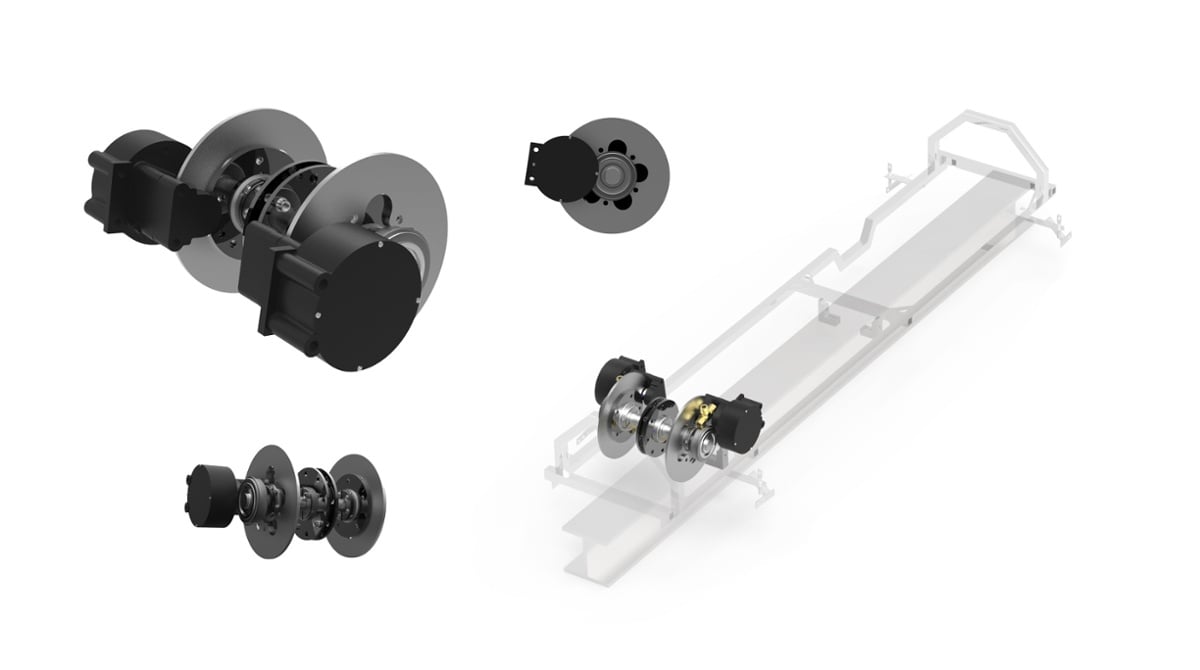
When industrial equipment needs reliable stopping power, caliper disc brakes are a common solution. These brakes use calipers to apply pressure against a rotating disc, creating friction that slows or stops motion.
OEMs have multiple options for industrial brakes, including electromagnetic, pneumatic, and hydraulic—as well as spring applied versions of each. The best choice depends on the application purpose, location, preferred (or available) power source, and your budget.
Spring applied caliper disc brakes work opposite of how standard brakes work—instead of applying pressure to engage the brake, pressure is applied to overcome the spring force and disengage the caliper. When power is removed, the springs force the brake to reengage. The springs in the fail-safe units produce greater braking force than standard brakes, making them more reliable and safer for loads that are suspended or in linear motion.
Selecting the Right Spring Applied Caliper Disc Brake
When sizing a spring applied caliper disc brake, first determine your application:
- Direction of Motion Applications: Will the brake be used to stop a rotating disc or is the application linear?
- Dynamic Stopping Applications: Consider the weight of rotating mass, radius gyration based on shape, RPM, and required stopping time.
- Static Holding Applications: Determine the amount of torque required to hold, then select a brake and disc diameter that provides that torque.
Each spring applied brake specifies the tangential force it provides. Coupling that force with the braking radius gives the amount of braking torque provided. If the application is linear, the tangential force with which the brake is rated for is used to determine maximum load.
Types of Spring Applied Brakes Compared
Pneumatic Spring Applied Brakes
Compressed air is often a staple in industrial settings, making pneumatic spring applied brakes a popular choice. The brakes typically operate between 70-120 psi, with between 85 and 100 psi necessary to release a brake caliper.
Advantages:
- Comparatively inexpensive considering the amount of brake force provided by the product
- Lowest operating costs—maintaining continuous air pressure is cheaper than intermittent electricity
- Ideal for clean environments with no risk of fluid leakage
- Can operate in environments where hydraulics or electricity are not available
Hydraulic Spring Applied Brakes
Hydraulic systems can exert tremendous pressure. Because of that, hydraulic brakes offer greater brake force in a smaller envelope. Similar to pneumatic spring applied models, hydraulic spring applied brakes are common in applications where emergency stopping and holding heavy-duty industrial equipment is necessary. They're also suitable for wind turbines.
Note: In dynamic applications, spring torque diminishes as friction pad wear increases, reducing braking power.
Electromagnetic Brakes
Electromagnetic brakes provide powerful slowing and stopping capabilities for manufacturing and indoor industrial facilities but are most commonly used with railroad trains and circular saws.
Advantages:
- Fast operation, beneficial for emergency braking
- Suitable for environments where hydraulic fluid leakage would pose problems
Disadvantages:
- Require sufficient voltage to support electromagnetic braking requirements
- Not suitable for space-limited applications
- More expensive to purchase and maintain due to complex design and components like copper
- Not ideal for harsh environments as internal components are sensitive to contaminants
Industry-Specific Applications and Benefits
Elevator Safety Systems
Critical Requirements:
- Immediate engagement during power loss
- Smooth, controlled deceleration
- Compact design for limited machine room space
- Compliance with elevator safety codes
Benefits:
- Reliable emergency stopping power
- Low maintenance for difficult-to-access installations
- Consistent performance across varied load conditions
Overhead Gantry Systems
Critical Requirements:
- Precise load holding in any position
- Redundant safety features
Benefits:
- Multiple mounting options for various configurations
- Integrated wear monitoring
- Weather-resistant designs for outdoor installations
- Synchronized operation for multiple brake systems
Robotics and Automation
Critical Requirements:
- Fast response time
- Compact form factor
- Low maintenance requirements
Benefits:
- Minimal backlash for accurate positioning
- High torque-to-size ratio
- Easy integration with robotic control systems
Rotary Indexing Equipment
Critical Requirements:
- Precise stop positions
- Quick engagement and release
- High repeatability
- Minimal maintenance
Benefits:
- Accurate positioning for indexing operations
- Rapid cycling capability
- Consistent torque output
- Simple integration with indexing controls
Small Wind Turbines (up to 50kW)
Critical Requirements:
- All-weather operation
- Low maintenance in elevated installations
- Variable torque control
- Compact design
Benefits:
- Suitable for various wind conditions
- Protected design for outdoor exposure
- Simple integration with turbine control systems
- Cost-effective for smaller installations
Mining and Bulk Material Handling
Critical Requirements:
- Reliable operation in dusty, contaminated environments
- High torque capacity for heavy loads
- Emergency stopping capability for inclined conveyors
Benefits:
- Sealed design prevents contamination from mineral dust
- Multiple spring pack options for different conveyor sizes
- Built-in wear indicators simplify maintenance
Port and Marine Applications
Critical Requirements:
- Reliable operation in high-humidity conditions
- Quick response for load control
Benefits:
- Marine-grade materials and coatings
- Enclosed design protects critical components
- Compatible with existing pneumatic systems on vessels
Steel Manufacturing
Critical Requirements:
- High-temperature operation capability
- Reliable emergency stopping power
- Resistance to harsh industrial environments
Benefits:
- Special high-temperature seals and materials
- Rapid engagement for emergencies
- Protected components resist steel dust and debris
Choosing the Right Brake
Industrial settings vary in space, operating conditions, and braking requirements. Since the springs in pneumatic and hydraulic spring applied brakes carry tremendous force, they can match the torque output of electromagnetic brakes. The choice often comes down to other factors—or cost.
Another consideration is expertise—mechanical pneumatic and hydraulic systems are simpler to understand, which may be why they're so popular in industrial equipment design.
We recommend using our 20% rule to ensure enough braking force is available for any application. For unique needs, custom modifications are possible, from simple changes like repositioning mounting holes to complex designs like creating more powerful brakes or ones that release at lower pressure.
For more information on selecting and sizing a spring applied brake, visit our caliper disc sizing page.


